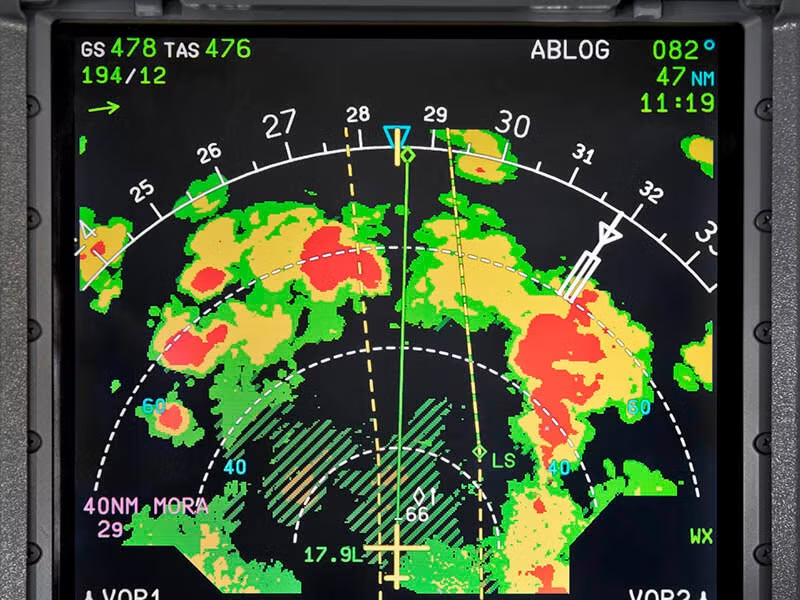At Six West Aviation, our delivery pilots regularly navigate some of the world’s most challenging weather conditions. After conducting hundreds of aircraft delivery flights through Southeast Asia and Africa, we’ve gathered invaluable insights from our flight crews about thunderstorms and their avoidance in these regions. Here’s what our pilots have learned on the front lines.
Our Six West Aviation pilots consistently report that Southeast Asia and Africa present some of the most dynamic weather environments they’ve encountered. One experienced captain who has completed many deliveries through these regions notes: “The speed at which these systems develop is remarkable—what looks like scattered clouds at departure can become towering cumulonimbus within an hour.”
The Intertropical Convergence Zone (ITCZ) migration, monsoon patterns, and intense solar heating create convective systems that routinely exceed 60,000 feet—a reality our pilots face regularly when delivering aircraft through these regions.
In Southeast Asia, the southwest monsoon (May-September) and northeast monsoon (November-March) create predictable but intense weather windows. Indonesia, Malaysia, and Thailand deliveries typically encounter afternoon and evening thunderstorm peaks, while morning departures often provide clearer conditions.
For African routes, our pilots describe the West African monsoon system as particularly challenging, with storm complexes spanning hundreds of miles. One pilot who specialises in African deliveries explains: “The Ethiopian Highlands and East African Rift Valley can turn a routine delivery into a chess game against rapidly developing storms.”
Route Selection: Our operations team works closely with pilots to analyse meteorological data before each delivery. One first officer who recently completed a challenging delivery through monsoon season shared: “The extra planning time pays off—we’ve learned that planning for extra track miles to avoid a storm system is always preferable to dealing with severe turbulence or emergency diversions.”
Timing is Everything: Our operations team have developed a keen sense for optimal departure windows. “In tropical regions, we’ve found that 0400-0800 local time departures often provide the best weather windows,” reports one of our senior operations managers, who regularly leads Southeast Asian delivery routes.
– “Never trust a gap that looks manageable—storms develop faster than you think”
– “20 nautical miles minimum clearance isn’t negotiable, go wider rather than go through”
– “If you’re questioning whether to deviate, you should have already started the turn”
– “Altitude changes need to happen fast—these storms can climb 3,000 feet per minute”
At Six West Aviation, we’ve found that crew resource management becomes even more critical in storm-prone regions. Our standard operating procedures include detailed weather briefings before every flight, with a specific focus on expected convective activity.
“Communication between crew members during weather deviations are an extremely important part of flight safety,” explains one of our experienced captains. Our highly trained and highly experienced crew work closely together to ensure the highest level of safety are maintained on each flight, while optimising the required service to our customers.
Our pilots also stress the importance of passenger communication with observers onboard during delivery flights. Proactive updates about weather-related route changes help everyone understand why that “direct” route to the destination isn’t always the safest choice.
Our Six West Aviation pilots provide regular feedback after challenging deliveries, sharing lessons learned and refining our procedures. This collaborative approach has led to improved routing strategies and better weather decision-making across our entire flight operations team.
As one of our senior captains puts it, “Every delivery flight through these regions teaches us something new. The weather patterns are evolving, and our techniques need to evolve with them.”

The feedback from our pilots continues to shape how we approach aircraft deliveries in these challenging but rewarding regions. Their experience reinforces that respect for the weather, thorough preparation, and conservative decision-making aren’t just best practices—they’re the foundation of safe operations.
Six West Aviation specialises in aircraft delivery flights worldwide. Our pilots’ experiences in Southeast Asia and Africa continue to inform our safety protocols and operational procedures. What weather challenges have you encountered in these regions?
